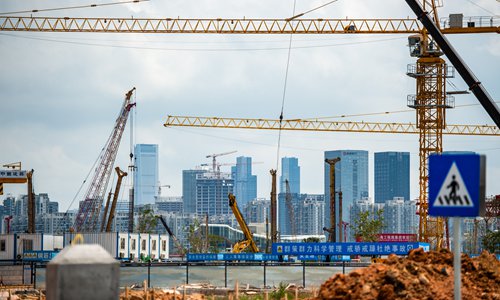HOME >> CHINA
Reconstruction of Shenzhen urban village sparks controversy as 80,000 to be affected
By Leng Shumei and Xu Keyue Source:Global Times Published: 2019/7/8 22:03:10
Shenzhen’s biggest village is transforming into homes, schools

Real estate projects under construction in Shenzhen, South China's Guangdong Province on March 21. Photo: IC
A reconstruction project of chengzhongcun (villages in the city, or urban villages) is agitating migrant workers in Shenzhen as reports say nearly 20,000 of them were required to move out of the area within two months despite growing rent and other problems.
The situation provides a glimpse of local government's dilemma in managing chengzhongcun, a result of China's urbanization process, experts said, noting that measures to handle such challenges should always be people-oriented.
An anonymous restaurant owner in Baishizhou chengzhongcun, Shenzhen, told the Global Times on Monday that his landlord had asked them to move before August 20 due to a reconstruction project of the urban village.
Many people are looking for new places, driving nearby rent higher by 1,000 yuan ($145) to 2,000 yuan, according to the owner. He said he could only move to distant areas to avoid high rent.
Another house agent surnamed Liu also confirmed with the Global Times that the area would be reconstructed. "Apartments in the area are only available for rent before the end of September."
The same thing is happening to about 20,000 Baishizhou residents, according to Chi Weiqi, chairman of the developer of the reconstruction project. Chi told the Nanfang Metropolis Daily that in two to three years, 80,000 would be removed due to the reconstruction.
Baishizhou, a 0.6-square-kilometer area consisting of five villages in Nanshan district, Shenzhen, is the biggest urban village in the city.
About 150,000 people live in 2,500 buildings in the area, media reported. Cheap rent and convenient traffic make it an ideal residence for most shenpiao people (those who move from elsewhere to Shenzhen).
Such villages also pose several challenges to urban governance, such as environment and security concerns, as they mostly include illegal buildings and produce large amounts of waste and occupy public space, media reported.
After the reconstruction, the area will be a compound community containing houses, offices, schools and nursing homes, according to the Shenzhen government.
"Chengzhongcun reduce the cost for migrant workers to live in cities at the start of urbanization," Niu Fengrui, a research fellow at the Chinese Academy of Social Sciences' Institute for Urban and Environmental Studies, told the Global Times.
"However, as urbanization proceeds, the management of these areas has become urgent due to various problems they created, such as a lack of public services and public security," Niu said.
Niu pointed out that reconstruction of chengzhongcun has been a long-standing issue for the Shenzhen government as the city started China's urbanization process.
In 2017, Beijing intensified a city-wide campaign to remove safety hazards especially among urban villages and dangerous houses after a fire in Daxing district killed 19 people, including eight children.
As the Beijing movement caused misunderstanding and controversy at that time, experts called for more humane measures and procedures to promote reconstruction of chengzhongcun in the country, giving full consideration to residents' demands and implementation based on local conditions.
Some successful experiences might be learned, for example, the reconstruction of Dachong village, another large urban village in Shenzhen which used to contain about 1,500 "handshake buildings."
In the Dachong project, the developer had started to prepare temporary houses for residents before relocation and the compensation was also made according to personal requirements, offering flexibility to residents; local governments also played an important role in protecting residents' interests, according to media reports.
Aside from the high cost to relocate, many others are also concerned about schooling issues. Local policies require parents to provide a rent contract of more than a year to allow them to send their children to nearby schools. As this year's admissions have ended, it is also difficult to find vacancies and transfers to schools in other districts.
In response, Chi said that it was inevitable that the project would bring inconvenience to residents. The company would try to give the residents more time to prepare and offer support to find new houses and send their children to school.
An anonymous worker at a local community also told the Nanfang Metropolis Daily that they were paying close attention to problems residents were facing in the reconstruction process.
Newspaper headline: Urban reconstruction to relocate 80,000
Posted in: SOCIETY